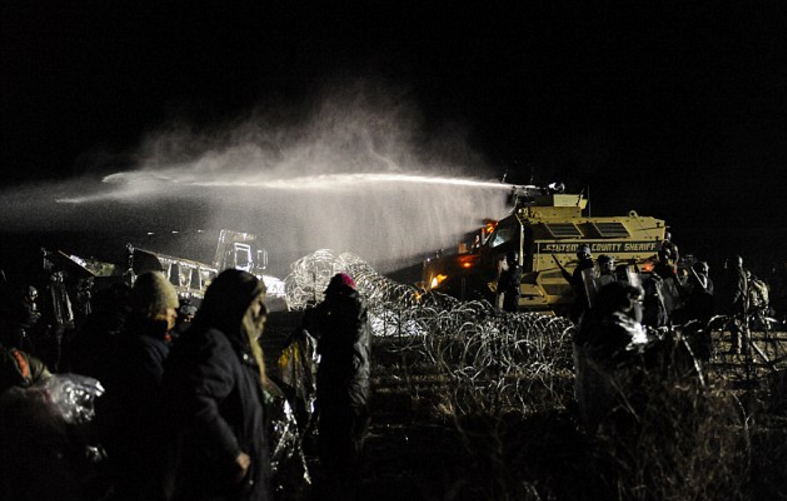
Tensions over the Dakota Access oil pipeline flared again Sunday when North Dakota law enforcement used water cannons to disperse a group of about 400 protesters trying to move past a barricaded bridge toward construction sites for the controversial project.
As temperatures in Cannon Ball, N.D., dropped into the 20s, police in riot gear sprayed anti-pipeline activists with a hose mounted on top of an armored vehicle and formed a line to prevent them from advancing up the road, according to the Bismarck Tribune. Protesters also reported being pelted with rubber bullets, tear gas and concussion grenades during the standoff, which lasted until late Sunday night.
A grainy Facebook Live video from the scene shows throngs of people gathered around the Backwater Bridge on Highway 1806, with flood lights shining down on the grass and road below, and a haze of smoke and water vapor rising near police vehicles.
The clashes began around 6 p.m., when protesters attempted to remove burned out trucks that had been blocking the bridge since authorities and activists faced off there in late October. Police have since set up wire and concrete barriers on the bridge, which is about a mile south of where the pipeline developer plans to drill.
Protesters, who call themselves “water protectors,” have argued that the barricade prevents emergency services from reaching the Standing Rock Sioux Reservation and a nearby camp they have used as a staging ground for demonstrations.
Authorities responded after protesters moved one of the trucks blocking the roadway. The Morton County Sheriff’s Department said that by 8:30 p.m. an estimated 400 people had arrived to try to “breach” the bridge and had set dozens of fires in the area. The department called the situation an “ongoing riot,” saying protesters were “very aggressive” and had attempted to “flank and attack the law enforcement line.” At least one person was arrested, the department said.
One of the protest organizers, Dallas Goldtooth, said protesters started small fires in the area to help warm people who had been sprayed with water in the freezing cold. He told the Tribune that some activists tried to remove the burned out trucks to expose the heavily-armed authorities behind them.
“Folks have a right to be on a public road,” Goldtooth said. “It’s absurd that people who’ve been trying to take down the barricade now have their lives at risk.”
Another organizer, Tara Houska, told the Tribune that more than 200 people had been hit with tear gas, pepper spray or water from the hose.
“They’re using everything and anything,” she said. “This has been weeks and weeks of those vehicles on the road for no apparent reason, and it’s a huge public safety risk. It’s putting enormous pressure on the Standing Rock Sioux community and people who live and work in the area.”
Organizers said the Cannon Ball gym was being used for emergency relief, with medics from the Standing Rock Sioux and Cheyenne River Sioux tribes treating people injured in the standoff.
Physicians and tribal healers with the Standing Rock Medic and Healer Council called on authorities to stop using water cannons against the protesters, saying the below-freezing weather could cause hypothermia and criticizing the “potentially lethal use of these controversial methods against people peacefully assembled,” CNN reported.
The sheriff’s department said water cannons were brought in to control the crowds and extinguish fires protesters had set in the area.
“There are multiple fires being set by protesters on the bridge and in the area of the bridge,” department spokeswoman Donnell Hushka told CNN. “We have firetrucks on the scene, they are using their fire hoses to put out the fires, wet the land around so fires don’t spread and they are also using water as crowd control.”
The department told the Tribune that the bridge had remained closed since October because transportation officials were concerned about its structural integrity.
The $3.8 billion pipeline is scheduled to carry crude oil nearly 1,200 miles from North Dakota to Illinois. Construction is nearly complete, but a planned segment of the project that crosses under the Missouri River has been a source of contention for months. The Standing Rock Sioux argue the pipeline cuts within a mile of their reservation and could pollute water and disrupt cultural sites. The tribe has challenged the project in court, and protesters have camped out near the Missouri River site for months.
Energy Transfer Partners, the project developer, says the pipeline transports oil more safely than trucks and will not harm sacred lands.
In October, a group of activists tried to set up a second protest camp closer to the area where drilling is set to take place. They blocked the roadway with scrap wood, bales of hay and tires, and used abandoned trucks to block the Backwater Bridge. After repeatedly ordering them to leave, authorities stormed the camp, deploying pepper spray, high-pitched warning tones and rubber bullets against those who refused to leave. More than 100 people were arrested.
Featured Image: Reuters
(c) 2016, The Washington Post · Derek Hawkins

